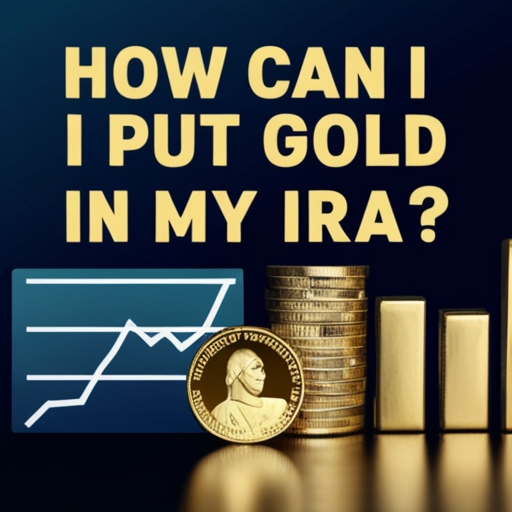Investing in a Gold IRA can be a strategic move for those looking to diversify their retirement portfolio. This type of self-directed IRA allows investors to hold physical gold and other precious metals, offering a unique opportunity for portfolio diversification and protection against economic uncertainties.
| Key Points |
|---|
| Gold IRAs allow investment in physical gold and other precious metals |
| Offers diversification and potential hedge against inflation |
| Requires understanding of IRS regulations and storage requirements |
| Provides tax advantages similar to traditional IRAs |
| Involves selecting a specialized custodian and secure storage facility |

What is a Gold IRA?
A Gold IRA is a specialized type of self-directed IRA that allows investors to hold physical gold and other precious metals in their retirement accounts. Unlike traditional IRAs, which typically focus on stocks and bonds, a Gold IRA provides a unique avenue for diversification.
This investment vehicle offers a way to protect retirement savings from market volatility and economic uncertainties. By including gold in your retirement plan, you can potentially benefit from its status as a safe-haven asset.
Setting up a Gold IRA involves selecting a custodian who specializes in precious metals. This custodian will guide you through the process and ensure compliance with IRS regulations.
Benefits of Investing in Precious Metals
Investing in precious metals like gold offers several advantages for your retirement strategy. One of the primary benefits is portfolio diversification, which can help reduce overall investment risk.
Gold is often considered a hedge against inflation, as it tends to maintain its value over time. This makes it an attractive option for those seeking to protect their wealth from economic downturns.
Additionally, Gold IRAs offer tax-deferred investment opportunities. This means you can enjoy potential tax advantages similar to those associated with traditional retirement accounts.
How to Open a Precious Metals IRA
Opening a Precious Metals IRA involves several key steps:
- Choose a reputable custodian specializing in precious metals
- Fund your IRA through a rollover or direct contribution
- Select IRS-approved gold products for your investment
- Arrange for secure storage in an approved depository
Your chosen custodian will guide you through this process, ensuring compliance with IRS regulations and helping you make informed decisions about your investments.
Types of Gold Investments Allowed in an IRA
The IRS has specific regulations regarding the types of gold that can be held in an IRA. These include:
- Gold bullion
- Gold coins (meeting certain purity standards)
- Gold bars
It's crucial to work with a knowledgeable custodian who can help you select IRS-approved gold products for your IRA. This ensures compliance with regulations and protects your investment.
Understanding IRS Rules for Gold IRAs
Compliance with IRS rules is essential when investing in a Gold IRA. These regulations cover aspects such as the purity standards for gold, storage requirements, and contribution limits.
One key rule is that the gold must be stored in an approved depository. This ensures the security and protection of your investment while maintaining compliance with IRS regulations.
It's also important to be aware of the annual contribution limits for IRAs. Staying within these limits helps avoid potential penalties and ensures the tax advantages of your Gold IRA.
Choosing a Custodian for Your Gold IRA
Selecting the right custodian is a crucial step in setting up and managing your Gold IRA. Look for a custodian with extensive experience in precious metals and a proven track record of compliance with IRS regulations.
Consider the range of services offered by the custodian, including assistance with IRA rollovers and transfers. It's also important to understand the fee structure associated with their services.
A reputable custodian should offer secure storage options and insurance for your gold investments. This ensures the protection of your assets and provides peace of mind.
How to Transfer or Rollover an Existing IRA to Gold
Transferring or rolling over an existing IRA to a Gold IRA can be a straightforward process with the right guidance. The first step is to choose a custodian who specializes in Gold IRAs.
You'll need to decide between a direct transfer or a rollover. A direct transfer involves moving funds directly from one IRA to another, while a rollover requires withdrawing funds and depositing them into the new Gold IRA within 60 days.
Once the funds are in your new Gold IRA, you can begin purchasing IRS-approved gold products for your investment portfolio.

Storage Options for Gold in an IRA
The IRS requires that gold held in an IRA be stored in an approved depository. This ensures the security and protection of your investment while maintaining compliance with regulations.
There are two main storage options for Gold IRAs:
1. Segregated storage: Your gold is stored separately from other investors' assets, providing an added layer of security.
2. Commingled storage: Your gold is stored alongside other investors' assets, often at a lower cost.
Consider factors such as security, accessibility, and cost when choosing a storage option for your Gold IRA.
Potential Risks of Investing in Gold
While gold can offer numerous benefits, it's important to be aware of potential risks associated with this investment. One primary risk is the volatility of the gold spot price, which can impact the value of your investment.
There's also the potential for fraud or scams in the precious metals market. Working with reputable custodians and dealers can help mitigate this risk.
Additionally, consider the costs associated with Gold IRAs, including storage fees, custodian fees, and transaction costs. These expenses can impact your overall returns and should be factored into your investment strategy.
Tax Implications of Gold IRAs
Gold IRAs offer several tax advantages, but it's crucial to understand the tax implications of these investments. One key benefit is the potential for tax-deferred growth, allowing your investment to grow without immediate tax consequences.
Contributions to a traditional Gold IRA may be tax-deductible, providing immediate tax savings. However, withdrawals from the account are subject to income tax.
Be aware of potential penalties for early withdrawals before age 59½. Understanding these tax implications can help you maximize the benefits of your Gold IRA while avoiding unexpected tax burdens.
Comparing Gold IRAs to Traditional IRAs
When evaluating Gold IRAs against traditional IRAs, several key differences emerge. The primary distinction lies in the types of investments allowed. Traditional IRAs typically focus on stocks and bonds, while Gold IRAs allow for investment in physical precious metals.
Gold IRAs offer unique benefits such as portfolio diversification and potential protection against economic uncertainties. However, they may involve higher fees due to storage and custodial requirements.
Consider your overall retirement strategy, risk tolerance, and financial goals when deciding between a Gold IRA and a traditional IRA.
How to Liquidate Gold from an IRA
Liquidating gold from an IRA involves several steps and considerations. First, contact your custodian to initiate the liquidation process. They will guide you through the necessary paperwork and procedures.
You'll need to decide whether to receive the proceeds in cash or as physical gold. If choosing cash, the custodian will sell the gold on your behalf and distribute the proceeds.
Be aware of the tax implications of liquidating gold from your IRA. Withdrawals are subject to income tax and may incur penalties if taken before age 59½.
Costs Associated with Gold IRAs
Investing in a Gold IRA involves several costs that should be considered in your overall strategy. These may include:
1. Custodian fees for account management and administration
2. Storage fees for securing your physical gold in an approved depository
3. Transaction fees for buying and selling gold within your IRA
Understanding these costs is crucial for evaluating the potential returns and benefits of your Gold IRA investment.
Evaluating the Performance of Gold Investments
Assessing the performance of your gold investments involves monitoring several factors. The gold spot price is a key indicator of the current market value of gold and can fluctuate based on various economic factors.
Consider the performance of gold in relation to other assets in your portfolio. Gold often moves inversely to stocks and bonds, providing a potential hedge during market downturns.
Evaluate the long-term trends in gold prices and consider how they align with your investment goals and retirement timeline.
Common Mistakes to Avoid with Gold IRAs
To maximize the benefits of your Gold IRA, it's important to avoid common pitfalls. One frequent mistake is not fully understanding IRS regulations, which can lead to penalties or disqualification of your IRA.
Another error is choosing an inexperienced or unreliable custodian. Proper research and due diligence are essential when selecting a custodian for your Gold IRA.
Avoid investing in non-IRS-approved gold products, as this can result in penalties and tax consequences. Always ensure that your gold investments meet IRS standards for purity and form.
Conclusion
Investing in a Gold IRA can be a valuable strategy for diversifying your retirement portfolio and protecting your wealth against economic uncertainties. By understanding the intricacies of Gold IRAs, including IRS regulations, storage requirements, and potential risks, you can make informed decisions about your investments.
Remember to choose a reputable custodian, consider the costs associated with Gold IRAs, and regularly evaluate the performance of your investments. With careful planning and management, a Gold IRA can provide a stable and potentially lucrative addition to your retirement strategy.
Frequently Asked Questions
What is the minimum investment required for a Gold IRA?
The minimum investment varies by custodian but typically ranges from $5,000 to $10,000. Some custodians may have lower minimums for getting started.
Can I hold other precious metals besides gold in my IRA?
Yes, IRS-approved precious metals for IRAs include gold, silver, platinum, and palladium, provided they meet specific purity standards.
How often should I rebalance my Gold IRA?
Rebalancing frequency depends on your investment strategy and market conditions. Many investors review their portfolio annually or semi-annually to ensure it aligns with their goals.

